Diverse applications of MoO3 for high performance organic photovoltaics: fundamentals, processes and optimization strategies
Abstract
The development of efficient and stable interface materials is an important part of the research in organic photovoltaics (OPVs), which aims to realize higher efficiency, longer lifetime, lower cost, easier fabrication, and wider applicability. MoO3 exhibits a suitable work function, adjustable electronic structure, favorable ohmic contact with organic materials, remarkable stability in the presence of water and oxygen, and excellent solution processing properties, making it an ideal anode buffer layer (ABL) for OPVs. This review analyzes the photoelectric characteristics of MoO3 based on the crystalline structure and its fundamentals as an ABL in OPVs. To simplify the fabrication procedure, AHM, MoO2(acac)2, and MoO3 powder are used as precursors for solution processing MoO3 buffer layers, and the attempts are still ongoing. Strategies of composite/hybrid formation, modification and doping are utilized to optimize the MoO3 ABL to obtain more efficient and stable OPVs. Combining the optical and electronic properties of MoO3, diverse applications are introduced in inverted, semi-transparent devices and tandem architectures, showing the wide applicability of MoO3 in OPVs. This review draws the outline of the relationships between the composition, structure and processing method of MoO3 and device performance, and further studies to fully understand it at a deeper level are highly needed, which is beneficial to improve the performance of OPVs and the research for solar cells with a similar structure, such as perovskite solar cells.



 Please wait while we load your content...
Please wait while we load your content...